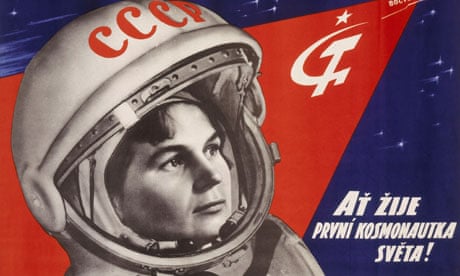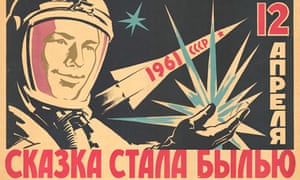My highlight: Cosmonauts at the Science Museum by Francis Spufford
This beautiful display captures the Soviet space programme as a place for licensed dreaming, and features space relics never before allowed out of Russia
Francis Spufford
Saturday 26 September 2015
The Science Museum’s new exhibition Cosmonauts: Birth of the Space Age moves from the actual events, spacecraft and personalities of the USSR’s post-Sputnik decade of triumph, into cosmonaut culture more widely – cosmonauts as the political heroes of Khrushchev’s renewed communism, as embodiments of both science and mystical philosophy; in art and film; and as a design cue for a vast amount of Soviet kitsch, from table lamps to cigarette cases to cocktail cabinets.
This beautiful display captures the Soviet space programme as a place for licensed dreaming, and features space relics never before allowed out of Russia
Francis Spufford
Saturday 26 September 2015
The Science Museum’s new exhibition Cosmonauts: Birth of the Space Age moves from the actual events, spacecraft and personalities of the USSR’s post-Sputnik decade of triumph, into cosmonaut culture more widely – cosmonauts as the political heroes of Khrushchev’s renewed communism, as embodiments of both science and mystical philosophy; in art and film; and as a design cue for a vast amount of Soviet kitsch, from table lamps to cigarette cases to cocktail cabinets.
Cosmonauts, too, as the centre of their own tiny, insular world of privilege and test-pilot superstition: because Gagarin had stopped on the way out to the launchpad and urinated on the right-back wheel of the bus, every cosmonaut on their way aloft did so ever after, and watched the same lucky film the night before, and listened to the same songs.

A poster celebrating the first woman cosmonaut
The obvious coups of the exhibition are its space relics: most have never before been allowed out of Russia, from Valentina Tereshkova’s charred descent capsule to the lunar lander of 1969 that would have carried a single cosmonaut to the moon had the N1 rocket not kept failing.
But Cosmonauts also does a beautiful job of opening, for the non‑Russian visitor, the peculiar vividness of the Soviet space programme as a place for licensed dreaming, a domain in the heart of the USSR’s military-industrial complex where an authoritarian society permitted itself visions that joined up the socialist future with the Orthodox Christian past, and the “heavens” into which each Vostok and Soyuz flew inherited an older, angelic iconography.

Boris Staris, The fairy tale became truth, 1961
Paradoxes abound. I had not known that it was the Zhdanovshchina, the brutal imposition of a narrow nationalist cultural policy after the second world war, that lifted Konstantin Tsiolkovsky up from obscurity as a Russian genius, and made spaceflight politically visible – only for the space programme, with its Cold War missile technology, to give the USSR one of its few sources of unforced international acclaim and glamour.

BP sponsors the show, and the politics of that are interesting too: supporting Soviet space nostalgia presses the right Russophile buttons for an oil company that wants Putin’s goodwill. Why would you expect innocence, in anything to do with a tyranny’s daydreams? The show is a cabinet of wonders. Don’t miss the chance to see it.
• Cosmonauts is at the Science Museum, London SW7 until 13 March 2016.

The Road Is Open for Humans by Konstantin Ivanov, poster 1960
BP sponsors the show, and the politics of that are interesting too: supporting Soviet space nostalgia presses the right Russophile buttons for an oil company that wants Putin’s goodwill. Why would you expect innocence, in anything to do with a tyranny’s daydreams? The show is a cabinet of wonders. Don’t miss the chance to see it.
• Cosmonauts is at the Science Museum, London SW7 until 13 March 2016.
Iraklii Toidze, In the Name of Peace, 1959









No comments:
Post a Comment